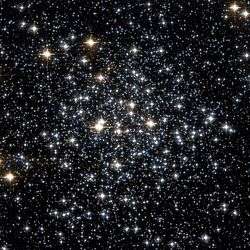Messier 71
| Messier 71 | |
|---|---|
|
| |
| Observation data (J2000 epoch) | |
| Class | X-XI |
| Constellation | Sagitta |
| Right ascension | 19h 53m 46.49s[1] |
| Declination | +18° 46′ 45.1″[1] |
| Distance | 13.0 kly (4.0 kpc)[2] |
| Apparent magnitude (V) | +6.1[3] |
| Apparent dimensions (V) | 7′.2 |
| Physical characteristics | |
| Mass | 1.7×104[4] M☉ |
| Radius | 13 ly[5] |
| Metallicity | = –0.78[6] dex |
| Estimated age | 9-10 Gyr |
| Other designations | M71, NGC 6838, GCl 115[3] |
| Wikimedia Commons has media related to Messier 71. |
Messier 71 (also known as M71 or NGC 6838) is a globular cluster in the constellation Sagitta. It was discovered by Philippe Loys de Chéseaux in 1745 and included by Charles Messier in his catalog of comet-like objects in 1780. It was also noted by Koehler at Dresden around 1775.
The star cluster is at a distance of about 12,000 light years away from Earth and spans some 27 light years across. The irregular variable star Z Sagittae is a member of this cluster.
M71 was long thought (until the 1970s) to be a densely packed open cluster and was classified as such by leading astronomers in the field of star cluster research due to its lacking a dense central compression, and to its stars having more "metals" than is usual for an ancient globular cluster; furthermore, it lacks the RR Lyrae "cluster" variable stars that are common in most globulars. However, modern photometric photometry has detected a short "horizontal branch" in the H-R diagram of M71, which is characteristic of a globular cluster. The shortness of the branch explains the lacking of the RR Lyrae variables and is due to the globular's relatively young age of 9-10 billion years. The relative youth of this globular also explains the abundance of "metals" in its stars. Hence today M71 is designated as a very loosely concentrated globular cluster, much like M68 in Hydra. M71 has a luminosity of around 13,200 Suns.

References
- 1 2 Goldsbury, Ryan; et al. (December 2010), "The ACS Survey of Galactic Globular Clusters. X. New Determinations of Centers for 65 Clusters", The Astronomical Journal, 140 (6): 1830–1837, arXiv:1008.2755
 , Bibcode:2010AJ....140.1830G, doi:10.1088/0004-6256/140/6/1830.
, Bibcode:2010AJ....140.1830G, doi:10.1088/0004-6256/140/6/1830. - ↑ Hessels, J. W. T.; et al. (November 2007), "A 1.4 GHz Arecibo Survey for Pulsars in Globular Clusters", The Astrophysical Journal, 670 (1): 363–378, arXiv:0707.1602
 , Bibcode:2007ApJ...670..363H, doi:10.1086/521780.
, Bibcode:2007ApJ...670..363H, doi:10.1086/521780. - 1 2 "SIMBAD Astronomical Database". Results for NGC 6838. Retrieved 2006-11-17.
- ↑ Marks, Michael; Kroupa, Pavel (August 2010), "Initial conditions for globular clusters and assembly of the old globular cluster population of the Milky Way", Monthly Notices of the Royal Astronomical Society, 406 (3): 2000–2012, arXiv:1004.2255
 , Bibcode:2010MNRAS.406.2000M, doi:10.1111/j.1365-2966.2010.16813.x. Mass is from MPD on Table 1.
, Bibcode:2010MNRAS.406.2000M, doi:10.1111/j.1365-2966.2010.16813.x. Mass is from MPD on Table 1. - ↑ distance × sin( diameter_angle / 2 ) = 13 ly. radius
- ↑ Boyles, J.; et al. (November 2011), "Young Radio Pulsars in Galactic Globular Clusters", The Astrophysical Journal, 742 (1): 51, arXiv:1108.4402
 , Bibcode:2011ApJ...742...51B, doi:10.1088/0004-637X/742/1/51.
, Bibcode:2011ApJ...742...51B, doi:10.1088/0004-637X/742/1/51.
External links
- Messier 71 on WikiSky: DSS2, SDSS, GALEX, IRAS, Hydrogen α, X-Ray, Astrophoto, Sky Map, Articles and images
- Messier71 @ SEDS Messier pages
- Messier 71, Galactic Globular Clusters Database page
- Messier 71, LRGB CCD image based on two hours total exposure
- Messier 71: an Unusual Globular Cluster, ESA\Hubble picture of the week.
- McCormac, James; Szymanek, Nik. "M71 – Globular Cluster". Deep Space Videos. Brady Haran.
Coordinates: ![]() 19h 53m 46.11s, +18° 46′ 42.3″
19h 53m 46.11s, +18° 46′ 42.3″

